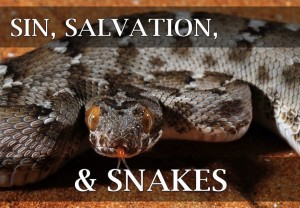Which animals do you fear the most?
For most of us, snakes rate high on the list of “a few of my least-favorite things.” Although we recognize the important role they play in nature, those slippery legless reptiles tend to show up when they are least welcome. Immediately we attempt to recall that life-saving ditty learned in childhood. Red touch yellow kill a fellow . . . is that how it went?
Whether you like snakes or fear them, how would you feel if these venomous creatures suddenly overtook your town with no purpose but kill everyone in their paths?
The ancient Israelites experienced that chilling scenario. For forty years they wandered and grumbled in the wilderness. They complained that they had nothing to eat (except, of course the manna that miraculously covered the ground every morning) or drink (except water that twice gushed out of a rock). God finally tired of their whining and dispatched lethally poisonous snakes into the camp.
The petrified people begged Moses to do something about the plague. I might have been tempted to keep the snakes around a little longer to thin out the masses of rebels, but not Moses. He complied and brought the petition to God.
God, however, refused to remove the snakes right away. He had a lesson to teach them first—a lesson about faith.
Although God allowed the snakes to stay around for a while, He arranged a rather unconventional method for the people to be healed when bitten. He commanded Moses to make a brass snake and attach it to a pole. Then He announced that “it shall be that everyone who is bitten, when he looks at it, shall live” (Numbers 21:8).
We could describe this plan with several adjectives: strange, unusual, or bizarre. However, we cannot leave out the most important adjective: effective. It worked.
What kind of healing powers could a brass snake affixed to a pole have? The answer: none. This is where the lesson of faith comes in.
Imagine that you have been bitten by a snake. You are lying on a cot in your tent, writhing in pain, and drifting in and out of consciousness. Suddenly a friend bursts through the doorway and announces that Moses has set up an image of a snake, and you really should take a look at it.
As a newly inducted member of the local ophiophobia society, a snake is the last thing you want to see. However, he persists in trying to persuade you that if you will only believe him and go take a look at the snake, you will live.
Slowly you ease yourself over the side of the bed and hobble toward the doorway, if for no other reason than to pacify your irritatingly persistent friend. He helps you negotiate the dusty path that leads toward the center of the camp. Then you see it. It’s a pole outfitted with the hideous likeness of a snake. However, you don’t gaze for long because as soon as you set your eyes on the image, your pain disappears. You are healed.
What healed you? Was it the act of looking at the “snake on a stick” or was it the faith it took to make you get up to do it?
To answer that question, we need to define faith. Faith is the conviction that something is true. If we are truly convinced that something is true, we will act on it.
The Israelites had to be convinced that Moses was telling the truth about the snake, or they wouldn’t have made the effort to go look at it.
Centuries later, Jesus referred to this historical event. Speaking of His coming death, He promised that “As Moses lifted up the serpent in the wilderness, even so must the Son of Man be lifted up, that whoever believes in Him should not perish but have eternal life” (John 3:14-15).
His point was that it is more than knowledge that provides salvation. Many people know all about Jesus, but have never gotten off their cot, so to speak, and come to Him in faith. It’s not enough to know. We have to trust. Just as it took faith for a dying man to trade the comfort of his bed for a look at a snake, it takes faith to turn our knowledge about Jesus into trust in Him alone. Without that, however, we will never experience salvation.
This article appeared in the Bremen Enquirer in my column Connections: Relating the Bible to Everyday Life on Thursday, July 21, 2016.



